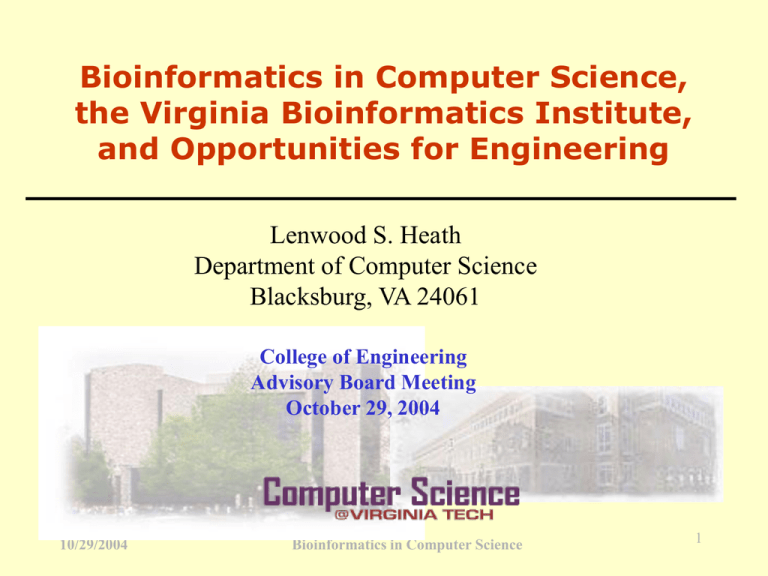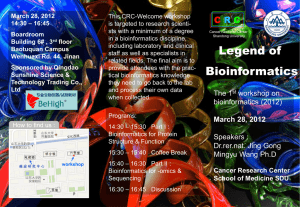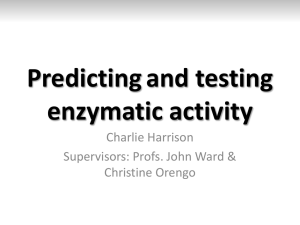Bioinformatics in Computer Science, The Virginia Bioinformatics
advertisement

Bioinformatics in Computer Science, the Virginia Bioinformatics Institute, and Opportunities for Engineering Lenwood S. Heath Department of Computer Science Blacksburg, VA 24061 College of Engineering Advisory Board Meeting October 29, 2004 10/29/2004 Bioinformatics in Computer Science 1 Overview • Computational biology and bioinformatics • The players • Computer Science • Virginia Bioinformatics Institute (VBI) • Others at VT • Opportunities for the College • • • • 10/29/2004 Collaboration with VBI SBES, Wake Forest School of Medicine NIH and DHS funding Scientific modeling Bioinformatics in Computer Science 2 Computational Biology and Bioinformatics • Computational biology — computational research inspired by biology • Bioinformatics — application of computational research (computer science, mathematics, statistics) to advance basic and applied research in the life sciences • Agriculture • Basic biological science • Medicine • Both ideally done within multidisciplinary collaborations 10/29/2004 Bioinformatics in Computer Science 3 Bioinformatics at VT (Part I) • Biological modeling (Tyson, Watson): > 20 years • Computational biology, genome rearrangements (Heath): > 10 years • Fralin Biotechnology sponsored faculty advisory committee centered on bioinformatics: 1998-2000 • Biochemistry; biology; CALS; computer science (Heath, Watson); statistics; VetMed • Provost provided $1 million seed money • First VT bioinformatics hire (Gibas, biology, 1999) 10/29/2004 Bioinformatics in Computer Science 4 Bioinformatics at VT (Part II) • Outside initiative submitted to VT for a campus bioinformatics center — 1998 • Discussions of bioinformatics advisory committee contributed to a proposal to the Gilmore administration — 1999 • Governor Gilmore puts plans and money for bioinformatics center in budget — 1999-2000 • Virginia Bioinformatics Institute (VBI) established July, 2000; housed in CRC 10/29/2004 Bioinformatics in Computer Science 5 Bioinformatics at VT (Part III) • Bioinformatics course and curriculum development began with faculty subcommittee — 1999 • Courses supporting bioinformatics now in many life science and computational science departments, including: • • • • • • Biology Biochemistry Computer Science Plant Pathology, Physiology, and Weed Science (PPWS) Mathematics Statistics 10/29/2004 Bioinformatics in Computer Science 6 Bioinformatics Education at VT • CS has been training CS graduate students in bioinformatics since 2000 • Graduate bioinformatics option established in a number of participating departments — 2003 • Ph.D. program in Genetics, Bioinformatics, and Computational Biology (GBCB) — 2003 • First GBCB students arrived, Fall, 2003; now in second year; completing core requirements 10/29/2004 Bioinformatics in Computer Science 7 Bioinformatics Spirit at VT • Close collaboration between life scientists and computational scientists from the beginning • Educational approach insists on adequate multidisciplinary background • Multidisciplinary collaborators work closely on a regular basis • Contributions to biology or medicine essential outcomes 10/29/2004 Bioinformatics in Computer Science 8 The Players • Computer Science • Virginia Bioinformatics Institute (VBI) • Others at VT 10/29/2004 Bioinformatics in Computer Science 9 CS Bioinformatics Faculty 1. 2. 3. 4. 5. 6. 7. 8. Chris Barrett (VBI, CS) Vicky Choi Roger Ehrich Edward A. Fox Lenny Heath T. M. Murali Chris North Alexey Onufriev 10/29/2004 9. 10. 11. 12. 13. 14. 15. Naren Ramakrishnan Adrian Sandu Eunice Santos João Setubal (VBI, CS) Cliff Shaffer Layne Watson Liqing Zhang Bioinformatics in Computer Science 10 Relevant Expertise • • • • • • • • • • • Algorithms — Choi, Heath, Santos, Setubal, Shaffer, Watson Computational structural biology — Onufriev, Sandu Computational systems biology — Murali Data mining — Ramakrishnan Genomics — Heath, Murali, Ramakrishnan, Setubal, Zhang Human-computer interaction, visualization — North Image processing — Ehrich, Watson Information retrieval — Ehrich High performance computing — Sandu, Santos, Watson Optimization — Watson Simulation — Barrett 10/29/2004 Bioinformatics in Computer Science 11 Established Bioinformatics Faculty • • • • • Layne Watson Lenny Heath Cliff Shaffer Naren Ramakrishnan Eunice Santos 10/29/2004 Bioinformatics in Computer Science 12 Layne Watson • Professor of Computer Science and Mathematics • Expertise: algorithms; image processing; high performance computing; optimization; scientific computing • Computational biology: has worked with John Tyson (biology) for over 20 years • JigCell: cell-cycle modeling environment; with Tyson, Shaffer, Ramakrishnan, Pedro Mendes of VBI • Expresso: microarray experimentation; with Heath, Ramakrishnan 10/29/2004 Bioinformatics in Computer Science 13 Lenny Heath • Professor of Computer Science • Expertise: algorithms; theoretical computer science; graph theory • Computational biology: worked in genome rearrangements 10 years ago • Bioinformatics: concentration in past 5 years • Expresso: microarray experimentation; with Ramakrishnan, Watson – Multimodal networks – Computational models of gene silencing 10/29/2004 Bioinformatics in Computer Science 14 Cliff Shaffer • Associate Professor of Computer Science • Expertise: algorithms; problem solving environments; spatial data structures; • JigCell: cell-cycle modeling environment; with Ramakrishnan, Tyson, Watson 10/29/2004 Bioinformatics in Computer Science 15 Naren Ramakrishnan • Associate Professor of Computer Science • Expertise: data mining; machine learning; problem solving environments • JigCell: cell-cycle modeling problem solving environment; with Shaffer, Watson • Expresso: microarray experimentation; with Heath, Watson – Proteus — inductive logic programming system for biological applications – Computational models of gene silencing 10/29/2004 Bioinformatics in Computer Science 16 Eunice Santos • Associate Professor of Computer Science • Expertise: Algorithms; computational biology; computational complexity; parallel and distributed processing; scientific computing • Relevant bioinformatics project: modeling progress of breast cancer 10/29/2004 Bioinformatics in Computer Science 17 New Bioinformatics Faculty • • • • • • • • T. M. Murali (2003) CS bioinformatics hire Alexey Onufriev (2003) CS bioinformatics hire Adrian Sandu (2004) CS hire João Setubal (Early 2004) VBI and CS Vicky Choi (2004) CS bioinformatics hire Liqing Zhang (2004) CS bioinformatics hire Chris Barrett (Fall 2004) VBI and CS One more bioinformatics position for Fall, 2005 10/29/2004 Bioinformatics in Computer Science 18 T. M. Murali • Assistant Professor of Computer Science • Hired in 2003 for bioinformatics group • Expertise: algorithms; computational geometry; computational systems biology • Projects: – Functional gene annotation – xMotif — find patterns of coexpression among subsets of genes – RankGene — rank genes according to predictive power for disease 10/29/2004 Bioinformatics in Computer Science 19 Alexey Onufriev • Assistant Professor of Computer Science • Hired in 2003 for bioinformatics group • Expertise: Computational and theoretical biophysics and chemistry; structural bioinformatics; numerical methods; scientific programming • Projects: – – – – – Biomolecular electrostatics Theory of cooperative ligand binding Protein folding Protein dynamics — how does myoglobin uptake oxygen? Computational models of gene silencing 10/29/2004 Bioinformatics in Computer Science 20 Adrian Sandu • Associate Professor of Computer Science • Hired in 2003 • Expertise: Computational science; numerical methods; parallel computing; scientific and engineering applications • Computational science: – New generation of air quality models – computational tools for assimilation of atmospheric chemical and optical measurements into atmospheric chemical transport models 10/29/2004 Bioinformatics in Computer Science 21 João Setubal • • • • Research Associate Professor at VBI Associate Professor of Computer Science Joined in early 2004 Expertise: algorithms; computational biology; bacterial genomes • Comparative genomics 10/29/2004 Bioinformatics in Computer Science 22 Vicky Choi • • • • Assistant Professor of Computer Science Hired in 2004 for bioinformatics group Expertise: computational biology; algorithms Projects: – Algorithms for genome assembly – Protein docking – Biological pathways 10/29/2004 Bioinformatics in Computer Science 23 Liqing Zhang • • • • Assistant Professor of Computer Science Hired in 2004 for bioinformatics group Expertise: evolutionary biology; bioinformatics Research interests: – Comparative evolutionary genomics – Functional genomics – Multi-scale models of bacterial evolution 10/29/2004 Bioinformatics in Computer Science 24 Bioinformatics Research in CS • • • • Collaboration Funding Resources Overview of projects 10/29/2004 Bioinformatics in Computer Science 25 Selected Collaborations • Virginia Tech: Biochemistry, Biology, Fralin Biotechnology Center, PPWS, Veterinary Medicine, VBI, Wood Science • North Carolina State University: Forest Biotechnology Center • Duke: Biology • University of Illinois: Plant Biology 10/29/2004 Bioinformatics in Computer Science 26 Selected Funding (Watson/Tyson) • NSF MCB-0083315: Biocomplexity---Incubation Activity: A Collaborative Problem Solving Environment for Computational Modeling of Eukaryotic Cell Cycle Controls. J. J. Tyson, L. T. Watson, N. Ramakrishnan, C. A. Shaffer, J. C. Sible. $99,965. • NIH 1 R01 GM64339-01: ``Problem Solving Environment for Modeling the Cell Cycle. J. J. Tyson, J. Sible, K. Chen, L. T. Watson, C. A. Shaffer, N. Ramakrishnan, P. Mendes (VBI). $211,038. • Air Force Research Laboratory F30602-01-2-0572: The Eukaryotic Cell Cycle as a Test Case for Modeling Cellular Regulation in a Collaborative Problem Solving Environment. J. J. Tyson, J. C. Sible, K. C. Chen, L. T. Watson, C. A. Shaffer, N. Ramakrishnan. $1,650,000. 10/29/2004 Bioinformatics in Computer Science 27 Selected Funding (Heath, et al.) • NSF IBN 0219322: ITR: Understanding Stress Resistance Mechanisms in Plants: Multimodal Models Integrating Experimental Data, Databases, and the Literature. L. S. Heath; R. Grene, B. I. Chevone, N. Ramakrishnan, L. T. Watson. $499,973. • NSF EIA-01903660: A Microarray Experiment Management System. N. Ramakrishnan, L. S. Heath, L. T. Watson, R. Grene, J. W. Weller (VBI). $600,000. • DARPA N00014-01-1-0852: Dryophile Genes to Engineer StasisRecovery of Human Cells. M. Potts, L. S. Heath, R. F. Helm, N. Ramakrishnan, T. O. Sitz, F. Bloom, P. Price (Life Technologies), J. Battista (LSU). $4,532,622. • NSF CCF 0428344: ITR-(NHS)-(sim): Computational Models for Gene Silencing: Elucidating a Pervasive Biological Defensive Response. L. S. Heath, R. F. Helm, A. Onufriev, M. Potts, N. Ramakrishnan. $1,500,000. 10/29/2004 Bioinformatics in Computer Science 28 Research Resources Available to CS Bioinformatics System X • Third fastest computer on the planet (2003) Laboratory for Advanced Scientific Computing & Applications (LASCA) • Parallel algorithms & math software • Anantham Cluster • Grid computing Bioinformatics Research LAN • Linux, Mac OS X • Bioinformatics databases and analysis 10/29/2004 Bioinformatics in Computer Science 29 JigCell: A PSE for Eukaryotic Cell Cycle Controls Marc Vass, Nick Allen, Jason Zwolak, Dan Moisa, Clifford A. Shaffer, Layne T. Watson, Naren Ramakrishnan, and John J. Tyson Departments of Computer Science and Biology 10/29/2004 Bioinformatics in Computer Science 30 Cell Cycle of Budding Yeast Sister chromatid separation Cdc20 PPX Lte1 Esp1 Budding Esp1 Pds1 Esp1 Bub2 Cdc15 Cln2 SBF Tem1 Net1P SBF Mcm1 Pds1 Unaligned chromosomes Net1 RENT Unaligned chromosomes Mcm1 Cdh1 Mad2 Cdc20 Cln3 Cdc14 Cdc20 Cln2 Clb2 Cdc15 and Clb5 Bck2 Mcm1 Clb2 Cdc14 growth CDKs Swi5 Sic1 DNA synthesis 10/29/2004 P Sic1 Cdh1 SCF Cdc14 ? MBF APC Clb5 Cdc20 Esp1 Bioinformatics in Computer Science 31 JigCell Problem-Solving Environment Experimental Database Wiring Diagram Differential Equations Analysis Parameter Values Simulation Automatic Parameter Estimation 10/29/2004 Visualization Bioinformatics in Computer Science 32 Why do these calculations? • Is the model “yeast-shaped”? • Bioinformatics role: the model organizes experimental information. • New science: prediction, insight JigCell is part of the DARPA BioSPICE suite of software tools for computational cell biology. 10/29/2004 Bioinformatics in Computer Science 33 Expresso: A Next Generation Software System for Microarray Experiment Management and Data Analysis 10/29/2004 Bioinformatics in Computer Science 34 Scenarios for Effects of Abiotic Stress on Gene Expression in Plants 10/29/2004 Bioinformatics in Computer Science 35 The Expresso Pipeline 10/29/2004 Bioinformatics in Computer Science 36 Proteus — Data Mining with ILP • ILP (inductive logic programming) — a data mining algorithm for inferring relationships or rules • Proteus — efficient system for ILP in bioinformatics context • Flexibly incorporates a priori biological knowledge (e.g., gene function) and experimental data (e.g., gene expression) • Infers rules without explicit direction 10/29/2004 Bioinformatics in Computer Science 37 Networks in Bioinformatics • Mathematical Model(s) for Biological Networks • Representation: What biological entities and parameters to represent and at what level of granularity? • Operations and Computations: What manipulations and transformations are supported? • Presentation: How can biologists visualize and explore networks? 10/29/2004 Bioinformatics in Computer Science 38 Reconciling Networks Munnik and Meijer, FEBS Letters, 2001 Shinozaki and YamaguchiShinozaki, Current Opinion in Plant Biology, 2000 10/29/2004 Bioinformatics in Computer Science 39 Multimodal Networks • Nodes and edges have flexible semantics to represent: - Time - Uncertainty - Cellular decision making; process regulation - Cell topology and compartmentalization - Rate constants - Phylogeny • Hierarchical 10/29/2004 Bioinformatics in Computer Science 40 Using Multimodal Networks • Help biologists find new biological knowledge • Visualize and explore • Generating hypotheses and experiments • Predict regulatory phenomena • Predict responses to stress • Incorporate into Expresso as part of closing the loop 10/29/2004 Bioinformatics in Computer Science 41 Fusion — Chris North • “Snap together” visualization environment • Interactively linked data from multiple sources • Data mining in the background 10/29/2004 Bioinformatics in Computer Science 42 Virginia Bioinformatics Institute (VBI) • Established by the state in July, 2000; high visibility • Applies computational and information technology in biological research • Research faculty (currently, about 18) expertise includes – – – – – Biochemistry Comparative Genomics Computer Science Drug Discovery Human and Plant Pathogens – – – – Mathematics Physics Simulation Statistics • More than $43 million funded research 10/29/2004 Bioinformatics in Computer Science 43 VBI Mission Statement At The Virginia Bioinformatics Institute, we research biological systems and design, develop and disseminate technologies to make discoveries that improve the quality of human life. We focus on understanding biology through systems that integrate the interaction between organisms and their environment for the benefit of science and society. We also strive to collaborate with the scientific community by enabling transformation of information into useful knowledge and by providing scientific services. 10/29/2004 Bioinformatics in Computer Science 44 The Disease Triangle 10/29/2004 Bioinformatics in Computer Science 45 Specialized VBI Facilities • Core lab facilities – – – – DNA sequencing Gene expression Proteomics Metabolomics • Core computational facilities – – – – Cluster computing dedicated to bioinformatics Data storage Visualization Database administration 10/29/2004 Bioinformatics in Computer Science 46 VBI Integration into Main Campus • Originally housed in Corporate Research Center • Partially moved to campus last year — Bioinformatics I building • Final move to campus, December, 2004 — Bioinformatics II building • Total space in Bioinformatics I and II will be 130,560 square feet 10/29/2004 Bioinformatics in Computer Science 47 VBI Research Portfolio ( by sponsor ) 38% 1% 1% National Institutes of Health 1% National Science Foundation 5% VT (JHU/ASPIRES/VTF) U.S. Dept of Defense 5% CTRF Other Academic Institutions Industry 12% U.S. Dept of Agriculture Foundations 25% 12% 10/29/2004 Bioinformatics in Computer Science 48 Funded Partnerships with VT Departments • • • • • • • • • • • • Aerospace and Ocean Engineering Biochemistry Biology Biomedical Science and Pathobiology, VMRCVM Computer Science Crop and Soil Environmental Sciences Electrical and Computer Engineering Fisheries and Wildlife Science Horticulture Mathematics Plant Pathology, Physiology, and Weed Science Statistics 10/29/2004 Bioinformatics in Computer Science 49 Opportunities for CS and the College of Engineering • • • • Collaboration with VBI SBES, Wake Forest School of Medicine NIH and DHS funding Scientific modeling 10/29/2004 Bioinformatics in Computer Science 50 Collaboration with VBI • Basic biological science — molecular biology, functional genomics, systems biology • Computational methods to answer biological questions from vast stores of VBI data resources • Computational models and simulation of biological systems, e.g., host-pathogen interaction 10/29/2004 Bioinformatics in Computer Science 51 SBES, Wake Forest • • • • • • • • Medical research includes significant computational challenges Much analysis can be done without additional lab biology Biomedical data analysis and mining Identification of genes responsible for complex traits More flexible and useful medical instrumentation Precise identification of disease Treatment suggestion Prognosis prediction 10/29/2004 Bioinformatics in Computer Science 52 NIH and DHS Funding • Bioinformatics is one of the New Pathways to Discovery in the NIH Roadmap • Computation is essential to advancing medical practice, from diagnosis to drug design • Department of Homeland Security (DHS) is funding research to respond to bioterrorism • Detection and identification of agents • Rapid response to threats • Modeling crisis impact and response 10/29/2004 Bioinformatics in Computer Science 53 Scientific Modeling • • • • • • Protein folding Protein function Protein-protein interaction Cellular signaling and decision processes Heart, lung, neurological function System X is an essential component 10/29/2004 Bioinformatics in Computer Science 54 Conclusion • Bioinformatics is an emerging area of opportunity, but challenging to enter • Rapid developments the norm; flexibility essential • Virginia Tech and the College are wellpositioned to take advantage 10/29/2004 Bioinformatics in Computer Science 55







